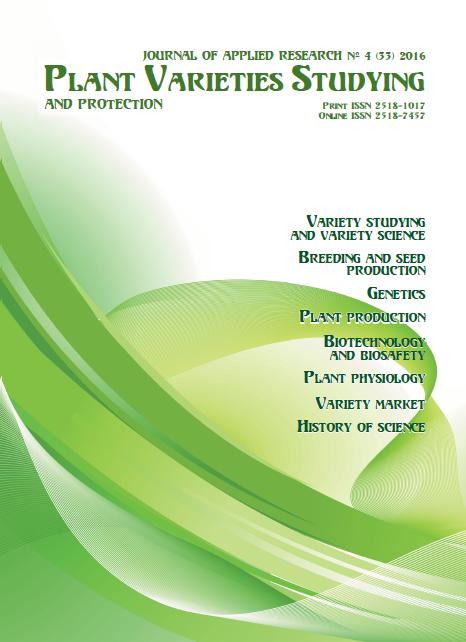Plant DNA banks for genetic resources conservation (review)
DOI:
https://doi.org/10.21498/2518-1017.4(33).2016.88669Keywords:
genetic erosion, biodiversity, genetic resources, plant DNA bankAbstract
Purpose. Literature review of DNA banks creation as the current strategy of plant genetic resources conservation.
Results. The current state of plant genetic resources conservation was analyzed in the context of the threat of genetic erosion. The importance of DNA banks was shown which function is to store DNA samples and associated products and disseminate them for research purposes. The main DNA banks in the world were described, including the Republican DNA Bank of Human, Animals, Plants and Microorganisms at the Institute of Genetics and Cytology of the National Academy of Sciences of Belarus. Stages of DNA banking were considered: tissue sampling (usually from leaves), cell destruction, DNA extraction, DNA storage. Different methods of tissue sampling, extraction and DNA storage were compared. The need for Plant DNA Bank creation in Ukraine was highlighted.
Conclusions. DNA collections is an important resource in the global effort to overcome the crisis in biodiversity, for managing world genetic resources and maximizing their potential.
Downloads
References
Food and Agriculture Organization of the United Nations. Retrieved from http://www.fao.org
National Centre for Plant Genetic Resources of Ukraine. Retrieved from http://www.yuriev.com.ua/index.php?option=com_content&view=article&id=270&Itemid=47&lang=en
Stierschneider, М., & Sehr, Е. M. (2016). A DNA repository platform for germplasm collection. In R. Kolliker, & B. Boller (Eds.), Plant Breeding: the Art of Bringing Science to Life : Abstracts of the 20th EUCARPIA General Congress (pp. 61). 29 Aug – 1 Sept 2016, Zurich, Switzerland.
Graner, A., Andersson, M. S., & de Vicente, M. С. (2006). A model for DNA banking to enhance the management, distribution and use of ex situ stored PGR. In M. C. de Vicente, & M. S. Andersson (Eds.), DNA Banks – Providing novel options for Genebanks? Topical reviews in agricultural biodiversity (pp. 69–76). Rome: IPGRI.
Adams, R. P. (1994). DNA Bank-Net – An overview. In R. P. Adams, J. S. Miller, E. M. Golderberg, & J. E. Adams (Eds.), Conservation of Plant Genes II: Utilization of Ancient and Modern DNA (pp. 1–13). St. Louis, Мо.: Missouri Botanical Garden.
Applequist, W. L., & Campbell, L. M. (Eds.). DNA Banking for the 21st Century: Proceedings of the U.S. Workshop on DNA Banking. (2014). St. Louis, Мо.: Missouri Botanical Garden.
Royal Botanic Gardens Kew. Retrieved from http://data.kew.org/dnabank/homepage.html
Plant DNA Bank in Korea. Retrieved from http://pdbk.korea.ac.kr/.
The New York Botanical Garden DNA Bank. Retrieved from http://sciweb.nybg.org/Science2/DNABank.asp
The Australian Plant DNA Bank. Retrieved from https://www.dnabank.com.au
DNA Bank at the Missouri Botanical Garden. Retrieved from http://www.wlbcenter.org/dna_banking.htm
DNA Bank Brazilian Flora Species. Retrieved from http://www.jbrj.gov.br/pesquisa/div_molecular/bancodna/sobre_ing.htm
DNA Bank at Kirstenbosch. Retrieved from http://www.sanbi.org/research/dnabank.htm
DNA Bank of the National Institute of Biological Sciences. Retrieved from http://www.dna.affrc.go.jp
Institute of Genetics and Cytology of the National Academy of Sciences of Belarus. Retrieved from http://gens.by
Protocol online. Retrieved from http://www.protocol-online.org/prot/Molecular_Biology/DNA/DNA_Extraction_Purification/DNA_Extraction_from_Plants/
DNA Extraction and Purification. Retrieved from https://www.labome.com/method/DNA-Extraction-and-Purification.html
Bonnet, J., Colotte, M., Coudy, D., Couallier, V., Portier, J., Morin, B., & Tuffet, S. (2010). Chain and conformation stability of solid-state DNA: implications for room temperature storage. Nucleic Acids Res., 38(5), 1531–1546. doi: 10.1093/nar/gkp1060
Savolainen, V., Powell, M. P., Davis, K., Reves, G., & Corthals, A. (Eds.). (2006). DNA and tissue banking for biodiversity and conservation: theory, practice and uses. Kew: Kew Publishing.
Hodkinson, T. R., Waldren, S., Parnell, J. A., Kelleher, C. T., Salamin, K., & Salamin, N. (2007). DNA banking for plant breeding, biotechnology and biodiversity evaluation. J. Plant Res., 120(1), 17–29. doi: 10.1007/s10265-006-0059-7
Gemeinholzer, B., Rey, I., Weising, K., Grundmann, M., Muellner, A. N., Zetzsche, H., ... Weigt, L. (2010). Organizing specimen and tissue preservation in the field for subsequent molecular analyses. In J. Eymann, J. Degreef, C. Häuser, J. Monje, Y. Samyn, & D. Van den Spiegel (Eds.), ABC-Taxa (Vol. 8: Manual on field recording techniques and protocols for all taxa biodiversity inventories, pp. 129–157). Brussels: Belgian Development Cooperation.
Downloads
Published
How to Cite
Issue
Section
License
Copyright (c) 2016 Ukrainian Institute for Plant Variety Examination

This work is licensed under a Creative Commons Attribution-ShareAlike 4.0 International License.
Starting in 2022, the copyright to the publication remains with the authors
Our journal abides by the CREATIVE COMMONS copyright rights and permissions for open access journals.
Authors, who are published in this journal, agree to the following conditions:
- The authors reserve the right to authorship of the work and pass the first publication right of this work to the journal under the terms of a Creative Commons Attribution License, which allows others to freely distribute the published research with the obligatory reference to the authors of the original work and the first publication of the work in this journal.
- The authors have the right to conclude separate supplement agreements that relate to non-exclusive work distribution in the form in which it has been published by the journal (for example, to upload the work to the online storage of the journal or publish it as part of a monograph), provided that the reference to the first publication of the work in this journal is included.

























 Ukrainian Institute for Plant Varieties Examination
Ukrainian Institute for Plant Varieties Examination  Селекційно-генетичний інститут
Селекційно-генетичний інститут Institute of Plant Physiology and Genetics of the National Academy of Sciences of Ukraine
Institute of Plant Physiology and Genetics of the National Academy of Sciences of Ukraine
 The National Academy of Agrarian Sciences of Ukraine
The National Academy of Agrarian Sciences of Ukraine